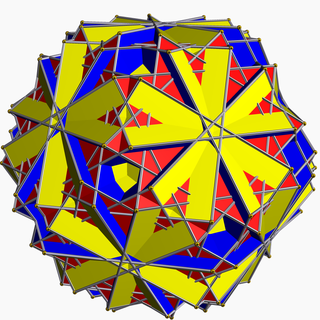Great truncated icosidodecahedron
This article needs editing to comply with Wikipedia's Manual of Style. In particular, it has problems with MOS:RADICAL. (June 2022) |
| Great truncated icosidodecahedron | |
|---|---|

| |
| Type | Uniform star polyhedron |
| Elements | F = 62, E = 180 V = 120 (χ = 2) |
| Faces by sides | 30{4}+20{6}+12{10/3} |
| Coxeter diagram | |
| Wythoff symbol | 2 3 5/3 | |
| Symmetry group | Ih, [5,3], *532 |
| Index references | U68, C87, W108 |
| Dual polyhedron | Great disdyakis triacontahedron |
| Vertex figure |  4.6.10/3 |
| Bowers acronym | Gaquatid |

In geometry, the great truncated icosidodecahedron (or great quasitruncated icosidodecahedron or stellatruncated icosidodecahedron) is a nonconvex uniform polyhedron, indexed as U68. It has 62 faces (30 squares, 20 hexagons, and 12 decagrams), 180 edges, and 120 vertices.[1] It is given a Schläfli symbol t0,1,2{5⁄3,3}, and Coxeter-Dynkin diagram, ![]()
![]()
![]()
![]()
![]()
![]()
![]() .
.
Cartesian coordinates
Cartesian coordinates for the vertices of a great truncated icosidodecahedron centered at the origin are all the even permutations of
- (±τ, ±τ, ±(3−1/τ)),
- (±2τ, ±1/τ, ±τ−3),
- (±τ, ±1/τ2, ±(1+3/τ)),
- (±√5, ±2, ±√5/τ) and
- (±1/τ, ±3, ±2/τ),
where τ = (1+√5)/2 is the golden ratio.
Related polyhedra
Great disdyakis triacontahedron
| Great disdyakis triacontahedron | |
|---|---|

| |
| Type | Star polyhedron |
| Face | 
|
| Elements | F = 120, E = 180 V = 62 (χ = 2) |
| Symmetry group | Ih, [5,3], *532 |
| Index references | DU68 |
| dual polyhedron | Great truncated icosidodecahedron |

The great disdyakis triacontahedron (or trisdyakis icosahedron) is a nonconvex isohedral polyhedron. It is the dual of the great truncated icosidodecahedron. Its faces are triangles.
Proportions
The triangles have one angle of , one of and one of . The dihedral angle equals . Part of each triangle lies within the solid, hence is invisible in solid models.
See also
References
- ^ Maeder, Roman. "68: great truncated icosidodecahedron". MathConsult.
- Wenninger, Magnus (1983), Dual Models, Cambridge University Press, doi:10.1017/CBO9780511569371, ISBN 978-0-521-54325-5, MR 0730208 p. 96
External links
- Weisstein, Eric W. "Great truncated icosidodecahedron". MathWorld.
- Weisstein, Eric W. "Great disdyakis triacontahedron". MathWorld.




